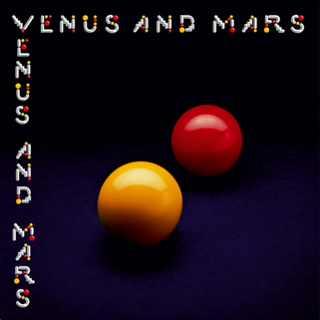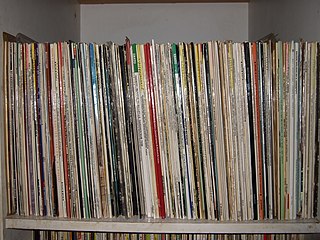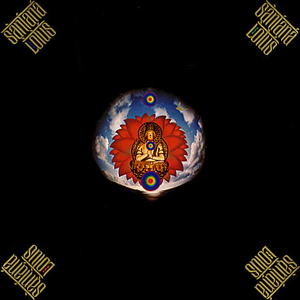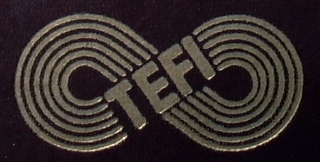
In music, a single is a type of release, typically a song recording of fewer tracks than an LP record or an album. One can be released for sale to the public in a variety of formats. In most cases, a single is a song that is released separately from an album, although it usually also appears on an album.

An extended play (EP) is a musical recording that contains more tracks than a single but fewer than an album or LP record. Contemporary EPs generally contain up to eight tracks and have a playing time of 15 to 30 minutes. An "EP" is usually less cohesive than an album and more "non-committal".

A phonograph record, a vinyl record, or simply a record or vinyl is an analog sound storage medium in the form of a flat disc with an inscribed, modulated spiral groove. The groove usually starts near the outside edge and ends near the center of the disc. The stored sound information is made audible by playing the record on a phonograph.

The twelve-inch single is a type of vinyl gramophone record that has wider groove spacing and shorter playing time with a "single" or a few related sound tracks on each surface, compared to LPs which have several songs on each side. It is named for its 12-inch (300 mm) diameter. This allows for louder levels to be cut on the disc by the mastering engineer, which in turn gives a wider dynamic range, and thus better sound quality. This record type is commonly used in disco and dance music genres, where DJs use them to play in clubs. They are played at either 33+1⁄3 or 45 rpm. The conventional 7-inch single usually holds three or four minutes of music at full volume. The 12-inch LP sacrifices volume for extended playing time.

A double album is an audio album that spans two units of the primary medium in which it is sold, typically either records or compact disc. A double album is usually, though not always, released as such because the recording is longer than the capacity of the medium. Recording artists often think of double albums as being a single piece artistically; however, there are exceptions, such as John Lennon's Some Time in New York City and OutKast's Speakerboxxx/The Love Below . Since the advent of the compact disc, albums are sometimes released with a bonus disc featuring additional material as a supplement to the main album, with live tracks, studio out-takes, cut songs, or older unreleased material. One innovation was the inclusion of a DVD of related material with a compact disc, such as video related to the album or DVD-Audio versions of the same recordings. Some such discs were also released on a two-sided format called DualDisc.

An album is a collection of audio recordings issued on a medium such as compact disc (CD), vinyl (record), audio tape, or digital. Albums of recorded sound were developed in the early 20th century as individual 78 rpm records collected in a bound book resembling a photo album; this format evolved after 1948 into single vinyl long-playing (LP) records played at 33+1⁄3 rpm.

An acetate disc is a type of phonograph record generally used from the 1930s to the late 1950s for recording and broadcast purposes and sees limited use as of 2009. Despite their name, "acetate" discs do not contain any acetate.

The overwhelming majority of records manufactured have been of certain sizes, playback speeds, and appearance. However, since the commercial adoption of the gramophone record, a wide variety of records have also been produced that do not fall into these categories, and they have served a variety of purposes.

Venus and Mars is the fourth studio album by the British–American rock band Wings. Released in May 1975 as the follow-up to Band on the Run, Venus and Mars continued Wings' run of commercial success and provided a springboard for a year-long worldwide tour. The album was Paul McCartney's first post-Beatles album to be released worldwide by Capitol Records rather than Apple.
In the field of recorded music, a hidden track is a song or a piece of audio that has been placed on a CD, audio cassette, LP record, or other recorded medium, in such a way as to avoid detection by the casual listener. In some cases, the piece of music may simply have been left off the track listing, while in other cases, more elaborate methods are used. In rare cases, a 'hidden track' is actually the result of an error that occurred during the mastering stage production of the recorded media. However, since the rise of digital and streaming services such as iTunes and Spotify in the late 2000s and early 2010s, the inclusion of hidden tracks has declined on studio albums.

Record collecting is the hobby of collecting sound recordings, usually of music, but sometimes poetry, reading, historical speeches, and ambient noises. Although the typical focus is on vinyl records, all formats of recorded music can be collected.

Sound recording and reproduction is the electrical, mechanical, electronic, or digital inscription and re-creation of sound waves, such as spoken voice, singing, instrumental music, or sound effects. The two main classes of sound recording technology are analog recording and digital recording.

Lotus is a 1974 live album by the Latin rock band Santana, recorded at the Osaka Kōsei Nenkin Kaikan, Osaka, Japan in July 1973, during their Caravanserai Tour. The Welcome album recording sessions were completed shortly before this concert, and that album was later released in November 1974. Lotus was originally released as a triple vinyl LP in Japan only. This version of the album was later released internationally.
The history of sound recording - which has progressed in waves, driven by the invention and commercial introduction of new technologies — can be roughly divided into four main periods:

The LP is an analog sound storage medium, a phonograph record format characterized by: a speed of 33+1⁄3 rpm; a 12- or 10-inch diameter; use of the "microgroove" groove specification; and a vinyl composition disk. Introduced by Columbia Records in 1948, it was soon adopted as a new standard by the entire US record industry. Apart from a few relatively minor refinements and the important later addition of stereophonic sound in 1957, it remained the standard format for record albums, during a period in popular music known as the album era. Beginning in the late 1970s, LP sales began to decline because of the increasing popularity of Compact Cassettes, then in the 1980s of compact discs (CDs). By 1988, the latter format began to outsell LPs.
This article details a comparison of audio recording mediums.

The Tefifon is an audio playback format, developed and manufactured in Germany, that utilizes cartridges loaded with an endlessly looped reel of plastic tape. It is somewhat similar to the later 4-track and 8-track magnetic audio tape cartridges, but with grooves embossed on the tape, like a phonograph record. The grooves were embossed in a helical fashion across the width of the tape, in a manner similar to Dictaphone's Dictabelt format. The grooves are read with a stylus and amplified pickup in the player's transport. A Tefifon cartridge, known as a "Tefi", can hold up to four hours of music; therefore, most releases for the format are usually compilations of popular hits or dance music, operas, and operettas. Tefifon players were not sold by television and radio dealers in Germany, but rather sold directly by special sales outlets affiliated with Tefi.

Electrical transcriptions are special phonograph recordings made exclusively for radio broadcasting, which were widely used during the "Golden Age of Radio". They provided material—from station-identification jingles and commercials to full-length programs—for use by local stations, which were affiliates of one of the radio networks.

Electric music technology refers to musical instruments and recording devices that use electrical circuits, which are often combined with mechanical technologies. Examples of electric musical instruments include the electro-mechanical electric piano, the electric guitar, the electro-mechanical Hammond organ and the electric bass. All of these electric instruments do not produce a sound that is audible by the performer or audience in a performance setting unless they are connected to instrument amplifiers and loudspeaker cabinets, which made them sound loud enough for performers and the audience to hear. Amplifiers and loudspeakers are separate from the instrument in the case of the electric guitar, electric bass and some electric organs and most electric pianos. Some electric organs and electric pianos include the amplifier and speaker cabinet within the main housing for the instrument.















